Table of Contents
Total Experience in Practice: The Roadmap to Seamless Customer and Employee Experiences
Many companies are still working to improve their customer experience or employee experience. But it is becoming increasingly clear that customer experience (CX) and employee experience (EX) cannot be separated – it is the total experience (TX) that counts. The trend is toward Total Experience Management (TXM).
But what does total experience mean? Is it more than just a buzzword? What do companies need to do to implement a total experience strategy – and what are the benefits? What are the methods for implementing, measuring, and improving Total Experience? And finally, how can direct feedback from customers, users, and employees be used to make Total Experience concepts really work?
In this article, we would like to give you some answers to the big trend topic of Total Experience. From the perspective of a large feedback platform that already provides EX and CX insights for more than 1,500 customers worldwide. Together with all our customers, we are on our way to becoming a Total Experience platform.
What is a Total Experience?
Let’s start with the basics – and take a step-by-step approach to Total Experience!
For many years now, our economy has been transforming more and more into an “experience economy”. This does not mean that we should only use emotional or subjective experiences. No, the reason is more concrete: because people’s experiences – whether as customers (CX) or as employees (EX) – sooner or later determine the success and profitability of companies.
For example, if a customer has an all-around positive experience with an eCommerce store – from the ordering process to delivery to a possible complaint – the customer experience is good. The customer will also give a high NPS score as a promoter. In the end, everyone wins; happy customers and happy businesses with many loyal repeat customers.
It’s a similar story with employee experience: again, it’s the entire employee experience (from the cafeteria to the boss’s behavior) that determines the eNPS score for recommending a company as an employer.
It’s the many little experiences that count – and that are so important.
Until now, however, companies have tended to view the various experience areas – such as CX or EX – as separate entities, and to deal with them in different departments. The HR team dealt with the employee experience using let’s say employee surveys, while sales and marketing started measuring the customer experience with a customer satisfaction survey.
However, there are very close connections between the experiences. To put it simply, the happier a company’s employees are, the better the customer experience will be.
And so, in 2022, Gartner analysts proclaimed the fusion of experiences – as “Total Experience”.
According to Gartner, the total experience consists of
- The Customer Experience (the customer experience) / CX
- The Employee Experience (the employee experience) / EX
- The User Experience (a user’s experience with a product, such as software) / UX
- The Multi Experience (the interaction when using different channels) / MX.
Servicenow, as a large digital platform, is also intensively propagating the trend towards Total Experience.
Why it pays for companies to take a look at Total Experience
Now you might say: Total Experience is just a buzzword. But it’s not. In fact, companies that actually connect the dots between the various experiences can benefit in a variety of ways.
A study by Gallup, for example, provides impressive evidence of this.
Their conclusion: highly successful companies with a great overall experience have both high employee satisfaction and high customer satisfaction. They transcend the departmental view and manage to act holistically.
And these companies have impressive metrics compared to their competitors:
- They have highly engaged employees who are up to 18% more productive and have lower turnover rates.
- They have sales that are 18% higher than average and higher customer satisfaction.
- And companies with high employee engagement are 23% more profitable than their peers.
Still, implementing Total Experience Management is fraught with uncertainty. As new as the term is, the approaches are unclear.
So here is a step-by-step guide to getting started with Total Experience!
Which industries are best suited for Total Experience?
Total Experience Management is suitable for all industries – after all, the goal is to create a positive customer experience with people. TXM is therefore also a sign of customer centricity. However, there are some industries that are predestined for Total Experience. These are usually very service-oriented offerings, where interaction between employees and customers is very important. For example:
- Hospitality and tourism
- Healthcare
- Retail
- Education and training.
But industries with a greater product focus also benefit from Total Experience, in particular, for example:
- Luxury goods sector (where a high-quality overall experience is important)
- Technology (innovative products)
- Automotive industry
Methods for Total Experience Management
Implementing a Total Experience (TX) approach requires a holistic approach that considers all aspects of customer interaction. Here are some methods and approaches that can be used to successfully implement a TX concept:
- Customer surveys and market research: Through surveys and market research, such as our survey tool, you can gain a better understanding of your customer’s needs, expectations, and preferences. This allows you to develop customized experiences that meet the specific needs of your target audience.
- Customer journey mapping: By mapping the customer journey, you can visualize a customer’s interactions and touchpoints with your organization. This allows you to identify weaknesses and opportunities to improve the overall experience.
- Design Thinking: Applying design thinking principles can help you develop innovative and customer-centric solutions. Focus on empathy, ideation, prototyping, and testing to create unique experiences.
- Cross-functional teams: Creating interdisciplinary teams from different departments, such as marketing, design, sales, customer service, and product development, can help take a holistic view and implement the TX concept across all areas of the business.
- Technology integration: Integrating modern technologies such as virtual reality, augmented reality, artificial intelligence, and the Internet of Things (IoT) can take the customer experience to a new level, providing an interactive and personalized experience.
- Training and education: Employees need to understand the TX concept and how to implement it in their daily work. Training and education is important to ensure a consistent customer experience.
- Emotional branding: Creating an emotional connection between your brand and customers can reinforce the TX concept. Stories, brand values and messages can help create a strong customer identification with your brand.
- Data analysis and feedback: Continuous analysis of customer data and collection of customer feedback is crucial to evaluate the impact of the TX concept and to make possible improvements.
- Continuous development: The TX experience is not a static concept, but should be continuously developed and optimized to meet the changing needs and expectations of customers.
- Experience on a platform: Evolving existing software tools, such as digital experience and feedback tools, into a TX platform.
You see: Total Experience is also a combination of methods. The integration of feedback – be it through surveys, interviews, or market research – plays a crucial role.
In the following, we will show you the structure of a Total Experience Management project from our perspective as a feedback platform.
How to develop your Total Experience Management (TXM) as an organization.
First, we’d like to let you in on a little secret. Or two. Let’s start with this:
Even though everyone is talking about “Total Experience” these days (and that includes large technology companies), there’s still a widespread lack of clarity about what Total Experience really means. And even more so, what Total Experience Management (TXM) looks like in practice! So every step you take to connect different experience domains, you’re breaking exciting new ground.
Or not. Because this is where secret number two comes into play: because what we often think of today as “Total Experience” is in many cases a positive business practice that has been around for centuries. Highly successful, customer-centric companies have always known that they rely on the enthusiasm and skills of their own employees – and that these are a key success factor for good customer experiences.
So Total Experience and the view of the total experience are not so new. What is new, however, is the attempt to technologically orchestrate the experience spaces and build common dashboards with KPIs to drive the business.
However, as companies embark on Total Experience projects, they need to be careful:
- Total Experience should ideally be owned directly by the C-suite as a “boss issue”.
- Total Experience requires mixed teams with members from different departments
- Total Experience requires agile decision-making and implementation processes and the use of appropriate methodologies.
In the following steps, for simplicity’s sake, we will look at Total Experience primarily from the combined perspective of Employee Experience and Customer Experience.
Step 1: Establish measurement processes: Analyze Your Overall Experience Readiness
William Hewlett, co-founder of the technology company Hewlett-Packard (HP), is famous for this quote:
“What gets measured gets managed.”
In other words, if you want to change something, you need to measure it first.
Fortunately, for both customer and employee experience, there are already common KPIs that many companies measure. Very often these are referral scores such as NPS or eNPS that are collected over time. These quantitative measures can also be supplemented with qualitative questions.
In order to arrive at a Total Experience strategy, a company must first ensure that it is systematically and regularly collecting CX AND EX metrics. Only then will the company be able to correlate both values.
Note: To start with Total Experience, your company must collect both Customer Experience and Employee Experience KPIs. Only then can they be combined into one platform.
If this is not the case, or if you only have KPIs for one of the areas, you will need to develop the missing KPIs.
And if you already have KPIs for both CX and EX, e.g. through customer or employee surveys, then you can move on: Consolidate the data!
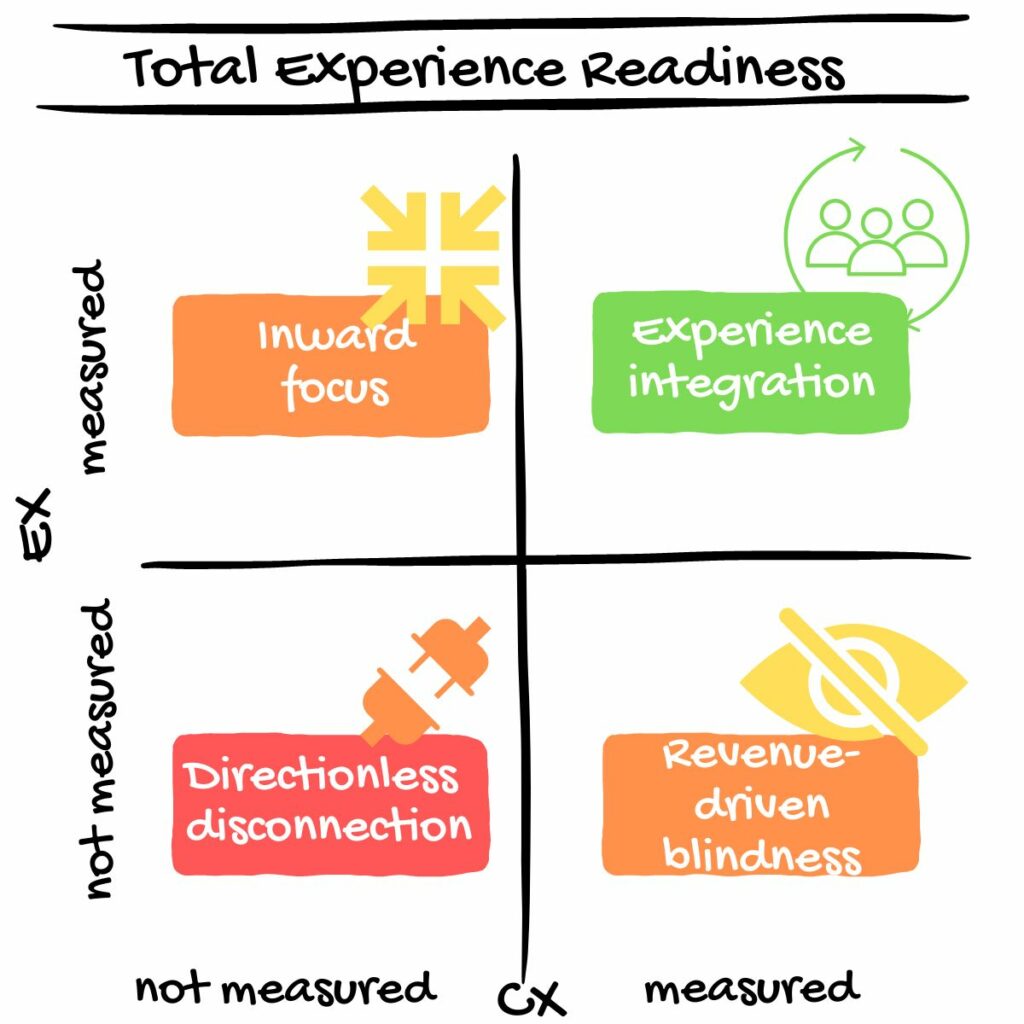
Step 2: Bring the experience data together: The Different Levels of Total Experience Excellence
Do you already measure CX and EX metrics? Congratulations! Then you are ready to merge the two worlds. You can transform your metrics into a Total Experience view.
But how do you do it?
Patchwork Alignment
Let’s face it: many companies and their departments start by crunching the numbers and comparing them. And that’s not a bad approach!
For example, do you see changes in employee satisfaction at a particular location and the resulting impact on sales? Bingo, you’ve made your first connection.
In the same way, you can always see connections to team building measures, personnel development measures, changes in management, etc. in comparison to other business figures.
And yet: This “patchwork” alignment is a good first step, but not a sustainable solution. When you look at contexts anecdotally, you may see that they have Total Experience approaches – but you have little ability to intervene with technological tools.
Cohesive Analysis
That’s why many companies rely on statistical correlations, which we call cohesive analysis. Again, you compare historical data and try to find statistical patterns. By the way, this is also the Total Experience measurement method often used in software platforms today.
Agile Fusion
The highest form of a total experience strategy, and one that has only rarely been achieved, is the “agile fusion” of data. For a functioning Total Experience Management (TXM), the goal must be to determine relevant Total Experience scores as automatically as possible, in real time, and to provide them with recommendations for action.
For example: the beginning of a high rate of sick leave is detected. In this case, the TXM must be able to trigger actions to mitigate this effect. For example, more marketing campaigns for the online store instead of on-site. Or hiring temporary staff. Or investigate why sick leave is so high. And on and on.
The practical benefits of such an integrated TXM system are very high. As I said, there are currently very few viable platforms that can do this for you. With your own resources, for example, by using our feedback platform and the Netigate consulting team, you can get closer to such a Total Experience vision.
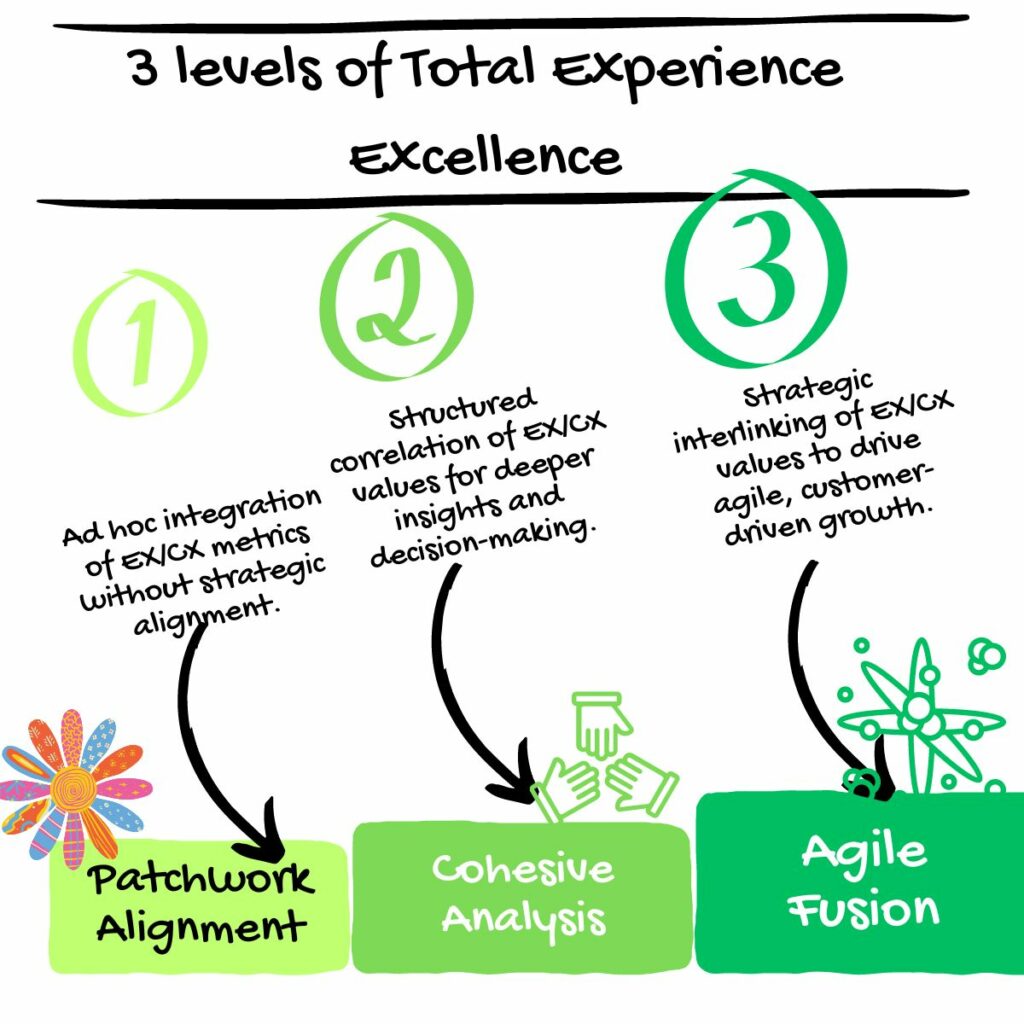
Step 3: Find pilot projects – Total Experience Management (TXM) in practice!
The difficulty with Total Experience is that it is a very abstract term. Let’s get a little more concrete – to understand the many use cases of Total Experience.
Let’s take the development of a new product as a case study. Product development is very important for companies – it should be done quickly, but also according to the needs of the customers. This is where the EX and CX spheres overlap again.
This diagram shows how they can be linked with common feedback loops to form a total experience:
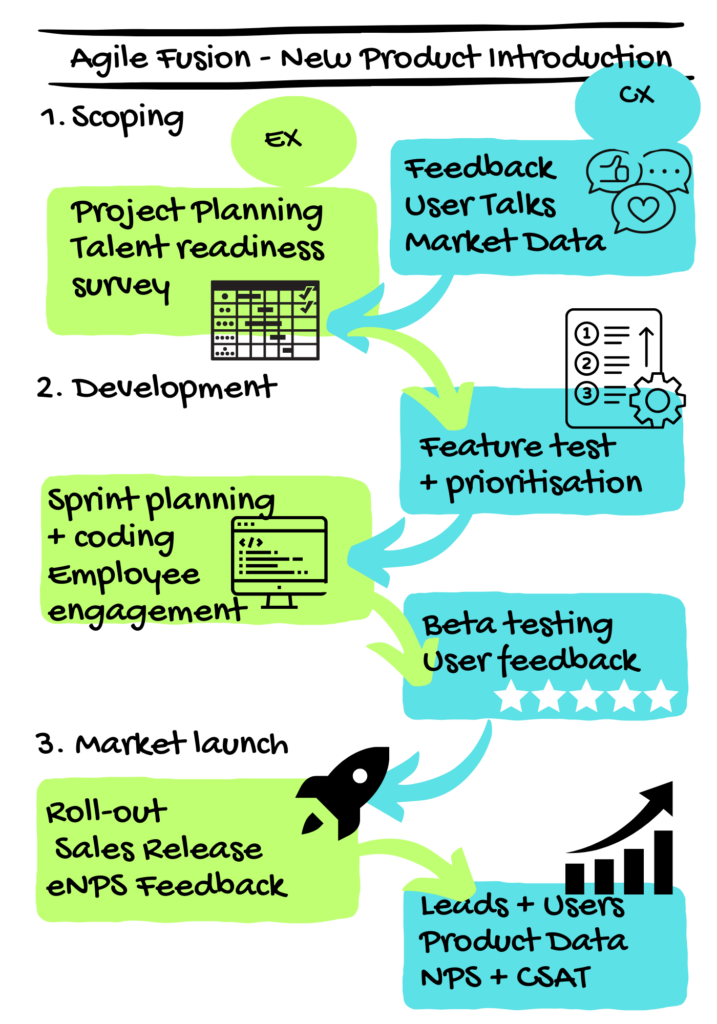
It all starts with customer feedback as the benchmark for customer experience. Customer interviews and market data create a CX picture of what the market expects from future product development.
This feedback feeds into the employee experience of project planning, which must include an analysis of the talent pool in the development teams. Do we have the right people with the right skills? This is where employee experience quickly comes into play.
In product development, too, the steps bounce back and forth like a ping-pong ball:
During development, customers test initial features. To keep agile development moving smoothly, development teams need to be kept on their toes with good morale. Then it’s on to beta testing and internal rollout – always a “world of experience” for internal teams as well, which is reflected in the EX experience.
Finally, there is the evaluation of the finished product by the customers, and a new Total Experience cycle is created with other stakeholders.
But the example shows: In many areas, customer experience and employee experience are very closely related. And: When companies manage to combine the different feedback loops, they can achieve outstanding results with excellent customer centricity.
Moreover, in this example alone, employees from different departments are involved.
The goal: A single cockpit for the enterprise for Total Experiences
The Total Experience will sooner or later determine the positive development of companies. Companies that add value to their Total Experience will grow faster and more profitably than others. Gartner, for example, speaks of up to 25% more growth for TX players.
Focusing on the Total Experience is therefore crucial for managers to operate successfully.
Every TXM program should therefore include the creation of a dashboard or “cockpit” (e.g. in PowerBI, or any other software suite). This contains all relevant key figures that have an impact on the total experience. Fed from a variety of sources, such a Total Experience dashboard provides immediate insight into the “state of the experience,” overcoming the previous “silo” view based on business unit data.
Key metrics in such a dashboard may include:
- Customer Satisfaction / NPS: Measures customer satisfaction with products/services and their overall experience with the company. This can be captured through customer surveys, reviews and feedback.
- Employee Satisfaction / eNPS: Measure employee satisfaction with their jobs, tasks, and relationship with the company. A positive employee experience can have a positive impact on the customer experience.
- Complaints and problem resolution: Track the number of customer service complaints and how well they were resolved. Effective problem resolution can have a positive impact on customer satisfaction.
- Loyalty and repeat business: Measure how often customers buy from you or use your services. Loyalty is a good indicator of a positive overall experience. Also measure your churn rates.
- Employee Retention: Monitor employee turnover and the average length of time employees stay with the company. High retention rates can indicate a positive employee experience.
- Innovation and improvement suggestions: Track the number of innovative ideas or improvement suggestions submitted by employees, customers, or other partners. This indicates stakeholder engagement.
- Brand perception: Measure how your brand is perceived by the public and customers. This can be captured through market research, social media interactions, and online reviews.
- Partner relationships: Consider the satisfaction of your suppliers and partners, as they can also influence the overall experience.
- Revenue growth: Track the growth of your business over time. Positive revenue growth can be an indicator of a good overall experience.
- Quality metrics: Depending on your industry, specific quality metrics such as product defect rates, on-time delivery, or service levels may be important.
- Diversity and inclusion: Consider diversity and inclusion in your organization to ensure that all stakeholders have a positive experience.
This graphic shows an example dashboard. With the values shown here, you can see, for example, a company that excels in internal procurement processes and employee satisfaction, but has problems with innovation and customer perception. In this case, the company could use the high employee motivation to initiate change processes.
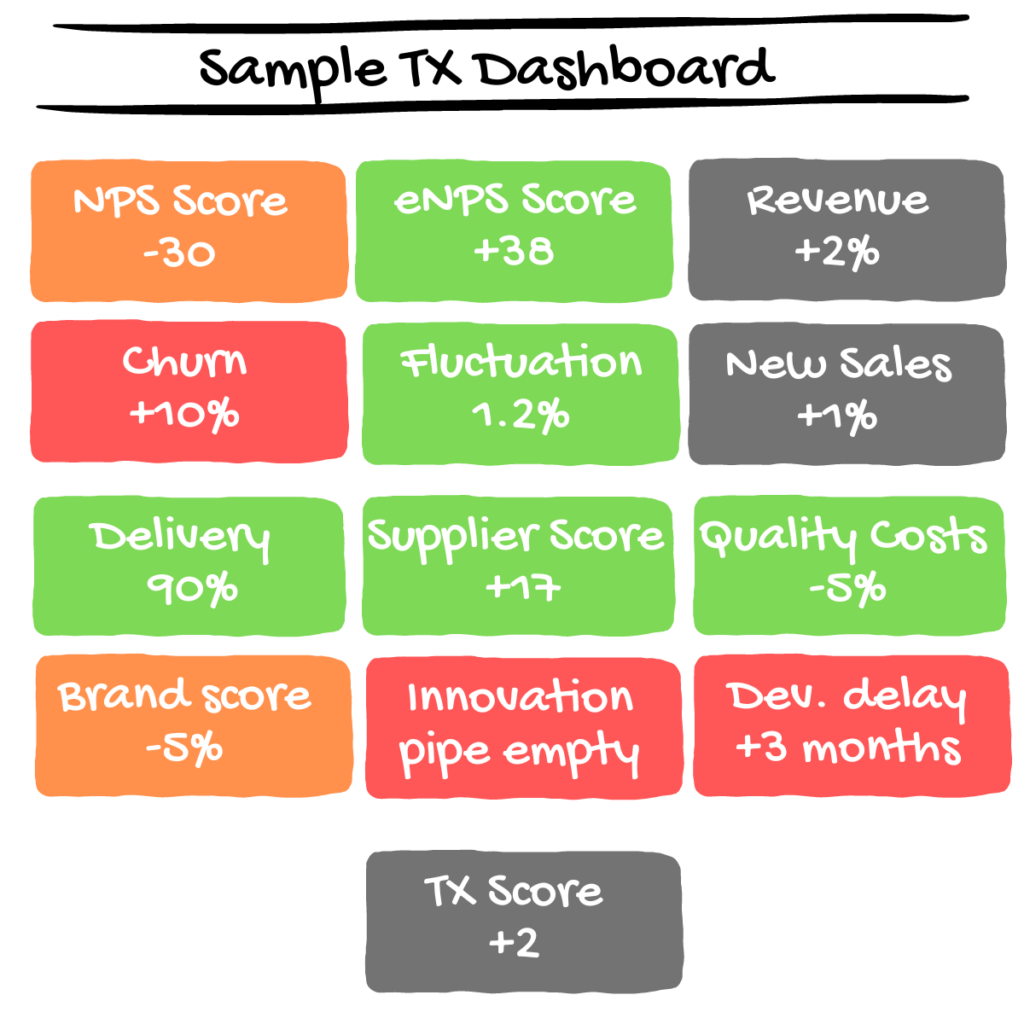
Leverage customer, employee, and stakeholder feedback for total experience strategy
The examples shown for a Total Experience strategy demonstrate that
- The total experience is the result of strategy, business decisions, and communication.
- In all cases, it is people who determine the quality of the experience.
- Total Experience Management (TXM) must be measurable, and this measurement is based on individual stakeholder feedback.
This also means that the systematic collection of feedback at all touchpoints of the total experience is crucial.
This feedback can be used in a TXM for the following 3 purposes:
- Evaluate actions: Measure whether specific activities have made a measurable contribution to either CX or EX improvement.
- Action Alert: If there are negative spikes in certain areas that impact the Total Experience, feedback can also trigger alerts. Example: High levels of sick leave in stores can trigger CX actions as changes in TX are expected.
- Prediction: As with employee experience and customer experience, feedback with AI models can increasingly be used to forecast short- and medium-term developments. This helps companies to better plan and manage their business.
The good news here is: The basic principle of feedback management changes very little. Customers, employees, and other stakeholders will continue to answer questions at their touchpoints-a learned and practiced behavior.
What will change is how this feedback is processed in the background and how it is merged with other key metrics (such as web data or other business metrics). This interplay between feedback data and other data sources creates entirely new application scenarios for using feedback.
Part of the total experience: the feedback journey
As described above, measuring and activating feedback is a core component of any total experience approach. Those who want to be successful in this area should therefore also adapt their feedback journey to the requirements of TX.
At Netigate, we define a feedback journey as the choreography of various feedback surveys over the course of a year. It doesn’t matter if these are employee or customer surveys: Typically, companies schedule 1 to 2 larger, regular surveys per year for these areas. These are supplemented by special surveys on specific topics or shorter pulse surveys. In addition, there are “transactional” surveys that are continuously displayed at various touchpoints (e.g., an NPS query after the completion of a purchase transaction).
To realize a total experience concept, companies must not only plan their individual feedback journeys for customer experience and employee experience, but also coordinate them with each other. This in turn requires the cooperation of different departments.
For example: If a customer survey is running, it makes sense to run it at the same time as an employee survey. By synchronizing the survey sequences, the results can be correlated. It also avoids distortions due to time factors (e.g. low participation rates, etc.).
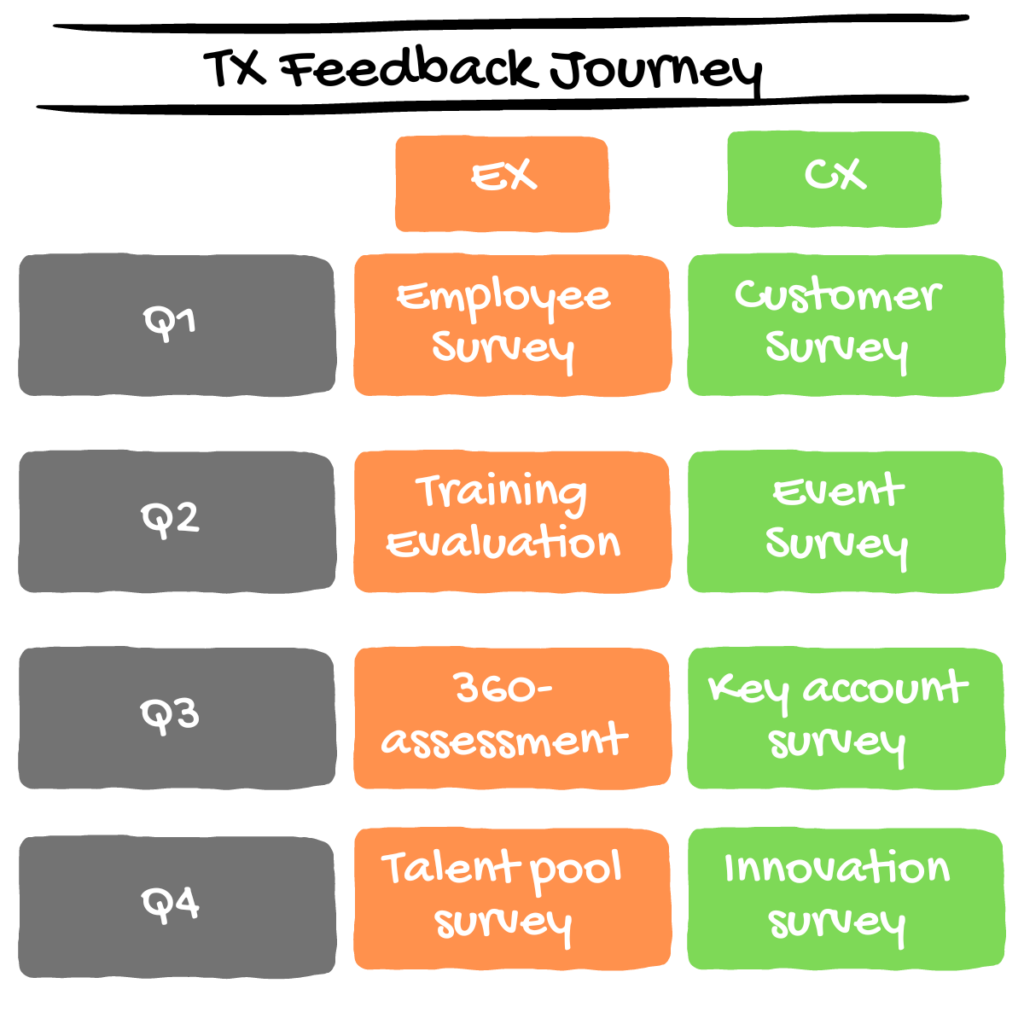
Is there such a thing as a TX score?
Total Experience is the interlocking of the experience worlds of customers, users, and employees. We have seen: Bringing these worlds together into one view requires not only efforts in the way of data collection but also an expanded view of management.
In this sense, the question arises whether there is not a “TX score” as a general indicator for Total Experience. A key performance indicator that, similar to an NPS or eNPS, allows for a quick ranking of a company’s TX development.
Well: a general TX score is currently not developed at all or has not yet become generally accepted. Nevertheless, every company can create such a TX score for itself.
And this is the way to your individual TX score:
- Start with your feedback program as described above. In this way, gather initial insights into the key factors that influence your Total Experience: These can be customer ratings, employee satisfaction, supplier relationships, brand perceptions, and other factors.
- Weight these factors, e.g., also with the help of an AI.
- Scale and normalize your data to a scale
- Feed your data into a score calculation.
Ultimately, however, a general “TX score” is the “crowning glory” of your activities, if you, for one, have committed to establishing a total experience strategy, measure your total experience measures in a feedback journey, and know about the influencing factors of various variables.
Conclusion: Total Experience – more than just a buzzword!
Total Experience is more than just a buzzword – it describes the merging of Customer Experience (CX) and Employee Experience (EX) into one total experience. It is a sign of high customer centricity. Companies should not view the experiences of customers, employees, and other stakeholders separately, as they are closely linked.
A successful total experience strategy can lead to impressive results, such as higher employee and customer satisfaction, increased productivity, revenue growth and a better competitive position. It is critical to systematically measure and bring together the different areas of experience to identify relevant relationships.
An organization should establish a total experience cockpit or dashboard that includes all relevant metrics that impact the total experience. These include customer satisfaction, employee satisfaction, Net Promoter Score (NPS), complaints and problem resolution, loyalty, innovation suggestions, and more.
Feedback from customers, employees, and other stakeholders is a valuable tool for the Total Experience strategy. It allows you to evaluate actions, identify red flags, and forecast short- and medium-term trends.
Although there is currently no standardized “TX score”, each company can develop its own individual TX score by weighting, scaling and normalizing the relevant factors. Such a score can provide a quick ranking of Total Experience.
Total Experience is a promising approach to making companies more successful and gaining competitive advantage. However, it requires a comprehensive view, measurement and integration of all areas of experience to realize its full potential.
The Netigate team supports you in developing dashboards and feedback journeys for your Total Experience Management (TXM), but also for the individual optimization of your Customer Experience or Employee Experience. Are you interested? Then contact us here.
-
Fabrizio Trotti
-
Fabrizio Trotti
- 15 min read
- .







 Copyright © 2025 Netigate AB, Drottninggatan 25, 111 51, Stockholm, Sverige
Copyright © 2025 Netigate AB, Drottninggatan 25, 111 51, Stockholm, Sverige